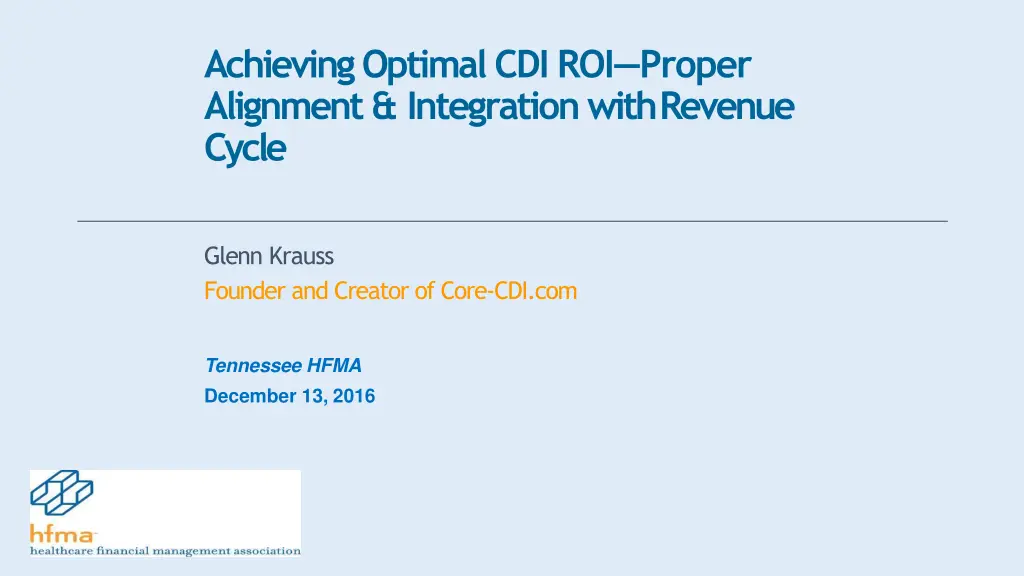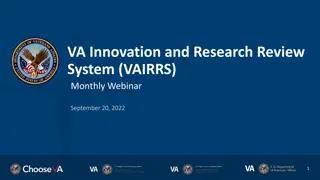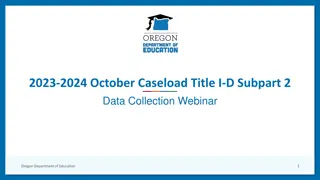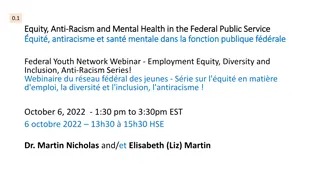
Achieving Optimal CDI ROI Alignment & Integration with Revenue Cycle
Explore the key provisions and pitfalls of CDI initiatives, learn how to engage physicians effectively, and understand the importance of aligning CDI with revenue cycle processes for a successful and measurable return on investment.
Download Presentation

Please find below an Image/Link to download the presentation.
The content on the website is provided AS IS for your information and personal use only. It may not be sold, licensed, or shared on other websites without obtaining consent from the author. If you encounter any issues during the download, it is possible that the publisher has removed the file from their server.
You are allowed to download the files provided on this website for personal or commercial use, subject to the condition that they are used lawfully. All files are the property of their respective owners.
The content on the website is provided AS IS for your information and personal use only. It may not be sold, licensed, or shared on other websites without obtaining consent from the author.
E N D
Presentation Transcript
Achieving Optimal CDI ROIProper Alignment & Integration with Revenue Cycle Glenn Krauss Founder and Creator of Core-CDI.com Tennessee HFMA December 13, 2016
Objectives UnderstandthefundamentalframeworkandkeyprovisionsofCDI initiatives which in turn serve as the basis for success and measureable,meaningful returnon investment(ROI). Outline pitfalls of traditional CDI programs and identifyopportunities to engage physicians in true CDI efforts that support the overall revenueBcycleprocess. 2
Objectives Learn what measures to utilize whenmeasuring and demonstrating reliableROIfromyourCDIprogram. Outlinehow besttoincorporateCDIinto aproactiveapproachto denials avoidance vs. a reactive approach to denials and appeals management. Learnhow torealign andmorecloselyintegrateCDI with therevenue cycle,fosteringacultureofdenialsavoidance 3
Clinical Documentation the Purpose Communicationof CareRenderedtoPatient Continuityofpatientcare Measures ofOutcomeand Quality FeeBforBValue Measures ofEfficiency Reimbursement&RevenueCycleProcesses Case Management & UtilizationReview Joint CommissionRequirements ConditionsofParticipation 4
Know ThyPurpose The medical record was first used by physicians to record their findingsandactions andas avehicletocommunicatewith other physicianswho might careforthepatientin thefuture. 5
PDI(akaCDI) WhatItIsandIsnt PDI vs. CRI PhysicianDocumentationImprovement vs. Clinical ReimbursementImprovement Outcomes vs. ProcessImprovement 7
CurrentFramework CDI Staff ReviewCharts Clinical Queries QueryResponse Coding & MSBDRGEnhancement Positive* CaseBMix & ReimbursementEffect 8
CurrentFramework Admission Asset vs.Liability Patient Encounter ChartReview CC/MCC, PDX, HCC, HACs,PSIs Process Documentation andCoding Billing andCollection Outcomes 9
MissingElements ProcessImprovement Driving Change in Physician DocumentationBehaviors Encompassing BirdsBEyeView Alignment & Integration with RevenueCycle 11
Current ProcessLimitations Episodic Repetitive; Only LowBHangingFruit NarrowScope Documentation Insufficiencies andInconsistencies Processvs.Outcomes ApproachandMindset KPI ReimbursementBFocused 12
Current ProcessLimitations Clinical Validation Clinical ContentandContextvs. BuzzWords ProgressNotes thatNeitherDescribeNor Show Progress Discharge Summaries that Fail to Capture DischargeInformation Insufficient Data Analysis, DataBMining, and ComputerMatching Potential for Increased MedicalBNecessityDenials Potential Incongruence with QualityDepartment 13
LimitingFactors Statusquo ConsultingCompanies Clinical ReimbursementImprovement Training Ingrained StandardizedProcess Skillsets,CoreCompetencies,andKnowledgebase LackofForces toDriveChange 14
BlindObedience Preoccupation withOutcomes AftereffectDeficient CognitiveBias Revenue CycleImpediment 16
Case inPoint HighestBCost MSBDRGs Consistently(2013). Total Costs: MajorJointreplacementor Reattachmentof LowerExtremity: $6.6 B Septicemia or Severe Sepsis: $5.56B Infectious &ParasiticDiseases: $2.18B Heart Failure & Shock: $2.11B SpinalFusionExceptCervical:$2.10 B 17
BedCensus Optimal Documentation, Coding andBilling Optimal Reimbursement 18
Current Key Performance Indicators(KPIs) # Casesreviewed #Cases queried(sentrequestforclarification toaprovider) % Cases queried $ Impact % Increase in CMI % Queries with DRG changes Query responserate 19
CurrentKPIs Secondarydiagnosis addition revenueversusnonBrevenueimpact SOI & ROMincrease Number of chartstouched FollowBuppercentage Days taken to opencase 20
CurrentKPIs Query agreementrate Provider groupsqueried Compliant Query templateusage Individual providersqueried 21
PotentialKPIs Net monthly caseBmix trends (CaseBmix achieved minusmedical necessity denialcaseBmix) Adjusted net patientrevenue Monthly netpatientrevenue medicalBnecessitydenialnet patientrevenue Medical necessitydenials Monthly denials $& % GPR 2 MidnightRule,Number and$ amount Clinical validation denials Monthly denials $and % GPR 23
PotentialKPIs Number ofqueriespostBcodingawaitingresponsetoretrospective query DNFB $ postBcodingawaitingresponsetoretrospectivequery Monthly totaland$ amountofclinicalvalidation denials Monthly totaland$ amountofmedicalnecessitydenials Number of rebills for HWDRBFCCBQIO 24
Net Patient RevenueLeakage Technical Clinical Validation Denials Medical Retrospective 25
Promoting Efficiency throughDocumentation RightCare RightTime RightReason RightDocumentation RightVenue Right Clinical Judgment & MedicalDecisionBMaking 26
Evaluation andManagement E& M Exchangeofclinicallyreasonableand necessaryinformation andthe useofthe informationin themanagementofthepatient Gather Process Transfer 27
Effective & CompleteDocumentation Effective & CompleteDocumentation Concise No fluff Accurate reporting ofacuity Natureofpresentingproblem ChiefComplaint Historyof PresentIllness vs. PastIllness Physicalexamreflectiveofnatureofpresentingproblem&clinicaljudgment Assessment Clinicalspecificity Diagnosis relevant to the patientencounter Trace back ofdiagnosis Planofcare congruentwithassessment 28
Medical RecordContent Medical Record Documentation and Content: The medical record is considered complete if it contains sufficient documentation to identify the patient,support the diagnosis, justify the treatment, and document the course and results of treatment and facilitate continuity of care. The medical record is sufficiently detailed and organized toenable: Theresponsiblepractitionertoprovidecontinuingcare,determinelaterwhat the patient s condition was at a specified time, and review diagnostic/therapeuticprocedures performed and the patient s response to treatment. 29
CDI Objective, Goals, and ValueStatement ValueStatement By securing a thorough, complete, and accurate patient health record, we will achieve the correct reimbursement for resource utilization, the highest quality measuresand outcomes,superiorcommunication betweenproviders,and ultimately high patient satisfaction. Goals andObjectives Promoteandachievecomplete,accurateandeffectiveclinicaldocumentationthat best serves to communicate the nature, value, quality, and outcomes of care provided that supports and reflects the complexity of care, clinician medical judgment,medicaldecisionmaking,thoughtprocessesandmedicalnecessity. CDIwillcloselyalignandintegratewith thegoalsandobjectivesoftherevenuecycle bypromotingandadvocatingfordocumentationdescribingandshowingthe clinical context,contentandfactsofthecasesupportiveofnetpatientrevenuethatstands the test oftime. 30
CDIMoving theNeedle Changing the Framework a NewParadigm Clinical Documentation Improvement is defined by the completeness, consistency,organizationandaccuracyofthemedicalrecord,reflectingthe physician'sclinicaljudgmentandmedicaldecisionmaking. CDI supports positive outcomes in patient care,quality,cost,resource consumption,feeforvalue,patientreimbursementandrevenuecycle processes. 31
8W Principles ofDocumentation Physicians focus oncapturing: 1. Where has the patientbeen? 2. Where is the patientnow? 3. What are youthinking? 4. Why you are thinkingthat? 5. Where are you going andwhy? 6. What did you find when you gotthere? 7. What actions did you take, what actions are still needed, and howlong is it going totake? 8. What actions remain for postBacutecare? 32
Eight Ws Principles ofDocumentation Incorporatingtheachievementof8 W sPrinciplesofDocumentationinto CDI Focus uponcapturing: Wherehasthepatientbeen? Whereisthepatientnow? Whatareyouthinking? Whyareyouthinkingthat? Whereareyougoingandwhy? Whatdidyoufindwhenyougot there? Whatactionsdidyoutake? What actions are still needed and how long is it going totake? WhatactionsremainforpostBacutecare? HPI HPI &PE Assessment Assessment Assessment Progress Notes,Assessment Plan ofCare Plan ofCare 33
Complete andAccurate All entries in the medical record must be complete. A medical record is considered complete if it contains sufficient information to identify the patient; support the diagnosis/condition; justify the care, treatment, and services; document the course and results of care, treatment and services; and promote continuity of care among providers. With this criteria in mind, an individual entry into the medical record must contain sufficient information on the matter that is the subject of the entry to permit the medical record to satisfy the completeness standard. 34
Communication of PatientCare PatientCare Communication of PatientCare (Medical Necessity) Clinical Judgment andMDM 35
The UndisputableGoal Achievement of DocumentationExcellence! Res IpsaLoquitur 36
Content &Context! Effective communication of patient care Rightcare Righttime Rightreason Rightvenue Rightdocumentation Right clinical judgment and medicaldecisionBmaking 37
WhiffTest PreviousadmissionsandaccurateandcompleteH&P Congruent picture does it tell thestory? Show and Describe no cliffnotes! Progress notes that demonstrateprogress! How about the dischargesummary? 38
GettingStarted What arethegoals andobjectivesoftheprogram? The 5 R s ofCDI Revisit Revise Reformulate Rebrand Reengineer 39
Operationalizing Focus Structure Process Track andTrend Standardize 40
FutureInvestment Reactive Proactive 41
MedicalNecessity Establishment of MedicalNecessity Number,acuity,severity,andduration ofproblemsand/or diagnoses the physician mustaddress. Number, type, and acuity of coBmorbiditiesthat impact physician clinical management of acute conditions and reason for admission/encounter. Contextandpreviousmanagementofclinical conditions. Amountofphysician workperformedin relationshiptophysical systems affected by patientproblems. 42
Gaining a ProperPerspective T ake astance GettingAhead oftheCurve Active vs. Reactive approach to documentationimprovement Content andContext ER H &P Progressnotes Dischargesummary 43
2 MidnightRule QIOswill,when conductingpatientstatus reviews,considerfactorsthat support a reasonable expectation relative to the 2Bmidnight benchmark. Thedecisiontokeepthebeneficiaryatthe hospitalandtheexpected durationofthestay arebasedon complexmedicalfactorssuch as: beneficiary medical history andcomorbidities. the severity of signs andsymptoms. current medicalneeds. risk(probability)ofanadverseeventoccurringduringthetime periodforwhichhospitalizationisconsidered. 44
Physicians need not include a separate attestation of the expected length of stay; rather , this information may be inferred from the physician sstandardmedicaldocumentation,suchashisorherplan of care, treatment orders, and physician snotes. Patient dynamically stable with no complaints Disposition admit inpatient for further workup PE: Patient alert and oriented X 3, resting comfortablywith no evident respiratorydistress Assessment:R/OMI patientchestBpainfreenow 45
What isKnown? QIOs will continue to follow longstanding guidance to review the reasonableness of the inpatient admission for purposes of PartA paymentbased on theinformation known tothe physicianatthe time ofadmission. The expectation for sufficient documentation is well rooted in good medical practice supported by evidence of medical necessity and qualityinsuchformandfashionandatsuchtimeas mayreasonably be required by a reviewing quality improvement organization in the exercise of its duties andresponsibilities. 46
Dont GetCaught Physicians need not include a separate attestation of the expected length of stay; rather , this information may be inferred from the physician sstandardmedicaldocumentation,suchashisorherplan of care, treatment orders, and physician snotes. Patient dynamically stable with no complaints Disposition admitinpatientforfurtherworkupand PE: Patient alert and oriented X 3, resting comfortablywith no evident respiratorydistress Assessment:R/OMI patientchestBpainfreenow 47
You Be the Judge Assessment: Abdominal pain,acuteBonBchronic Plan ofCare: Admit tohospitalasinpatient forfurtherworkupand management Start IVmedications Orderradiology Orderconsults Seeordersforfurtherinformation 48
Crossroads CurrentCDI FutureCDI Proactive Anticipatory Clinical facts what isknown Expandedscope ActionBpacked drama Meat of thestory Conclusion Retroactive Reactionary Narrowfocus Limited scope Cliffs Notes style of synopsis 50






















